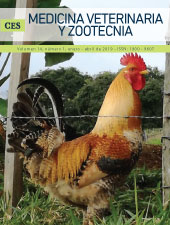Determination of Infectious Bovine Rhinotracheitis (BHV-1) in the municipality of Toca, Boyacá
DOI:
https://doi.org/10.21615/cesmvz.14.1.2Abstract
Introduction. Infectious Bovine Rhinotracheitis (IBR) is an Infectious contagious disease that mainly affects cattle and bufalin, being widely distributed worldwide, being one of the main causes of economic and physical losses in production. Objective. Determine the prevalence of Infectious Bovine Rhinotracheitis (BHV-1) in the municipality of Toca, Boyacá. Materials and methods. 350 Bovine blood samples were collected, which were processed in the laboratory of Universidad Pedagógica y Tecnológica de Colombia, through a commercial kit of ELISA. Results. The prevalence for IBR, in the municipality of Toca, Boyacá, was 65.5%. No significant relationship was found with the variables studied such as abortions, dystocias, non-pregnant cattle, repetition of estrus, among others. Conclusion. Infectious Bovine Rhinotracheitis is one of the main causes of economic losses in the various productions, however, it is not always the main cause of reproductive alterations present in Bovines.Downloads
References
REFERENCIAS
Ingelfinger JR, Gumz ML, Rabinowitz L, Wingo CS. An Integrated View of Potassium Homeostasis. N Engl J Med 2015;373:60–72. doi:10.1056/NEJMra1313341.
Longo DL, editor. Harrison’s principles of internal medicine. 18th ed. New York: McGraw-Hill; 2012.
Schaefer TJ, Wolford RW. Disorders of potassium. Emerg Med Clin North Am 2005;23:723–747, viii–ix. doi:10.1016/j.emc.2005.03.016.
Johnson RJ, Feehally J, Flöge J, editors. Comprehensive clinical nephrology. 5. ed. Philadelphia, Pa: Elsevier, Saunders; 2015.
Hall JB, Schmidt GA, Kress JP, editors. Principles of critical care. Fourth edition. New York: McGraw-Hill Education; 2015.
Eliacik E, Yildirim T, Sahin U, Kizilarslanoglu C, Tapan U, Aybal-Kutlugun A, et al. Potassium Abnormalities in Current Clinical Practice: Frequency, Causes, Severity and Management. Med Princ Pract 2015;24:271–5. doi:10.1159/000376580.
Jensen HK, Brabrand M, Vinholt PJ, Hallas J, Lassen AT. Hypokalemia in acute medical patients: risk factors and prognosis. Am J Med 2015;128:60–67.e1. doi:10.1016/j.amjmed.2014.07.022.
Widodo D, Setiawan B, Chen K, Nainggolan L, Santoso WD. The prevalence of hypokalemia in hospitalized patients with infectious diseases problem at Cipto Mangunkusumo Hospital, Jakarta. Acta Medica Indones 2006;38:202–5.
Paice BJ, Paterson KR, Onyanga-Omara F, Donnelly T, Gray JM, Lawson DH. Record linkage study of hypokalaemia in hospitalized patients. Postgrad Med J 1986;62:187–91.
Liamis G, Rodenburg EM, Hofman A, Zietse R, Stricker BH, Hoorn EJ. Electrolyte disorders in community subjects: prevalence and risk factors. Am J Med 2013;126:256–63. doi:10.1016/j.amjmed.2012.06.037.
McKean SC. Principles and practice of hospital medicine. New York: McGraw-Hill Medical; 2012.
Huang C-L, Kuo E. Mechanism of Hypokalemia in Magnesium Deficiency. J Am Soc Nephrol 2007;18:2649–52. doi:10.1681/ASN.2007070792.
Clausen T. Na+-K+ pump regulation and skeletal muscle contractility. Physiol Rev 2003;83:1269–324. doi:10.1152/physrev.00011.2003.
Halperin ML, Goldstein MB, Kamel KS. Fluid, electrolyte, and acid-base physiology: a problem-based approach. 4th ed. Philadelphia, PA: Saunders/Elsevier; 2010.
Aronson PS, Giebisch G. Effects of pH on potassium: new explanations for old observations. J Am Soc Nephrol JASN 2011;22:1981–9. doi:10.1681/ASN.2011040414.
Zierler K. Insulin hyperpolarizes rat myotube primary culture without stimulating glucose uptake. Diabetes 1987;36:1035–40.
Youn JH, McDonough AA. Recent advances in understanding integrative control of potassium homeostasis. Annu Rev Physiol 2009;71:381–401. doi:10.1146/annurev.physiol.010908.163241.
Giebisch G, Krapf R, Wagner C. Renal and extrarenal regulation of potassium. Kidney Int 2007;72:397–410. doi:10.1038/sj.ki.5002288.
Adrogué HJ, Madias NE. Changes in plasma potassium concentration during acute acid-base disturbances. Am J Med 1981;71:456–67.
Magner PO, Robinson L, Halperin RM, Zettle R, Halperin ML. The plasma potassium concentration in metabolic acidosis: a re-evaluation. Am J Kidney Dis Off J Natl Kidney Found 1988;11:220–4.
Juel C. Lactate-proton cotransport in skeletal muscle. Physiol Rev 1997;77:321–58.
Aickin CC, Thomas RC. An investigation of the ionic mechanism of intracellular pH regulation in mouse soleus muscle fibres. J Physiol 1977;273:295–316.
Schwarz KC, Cohen BD, Lubash GD, Rubin AL. Severe acidosis and hyperpotassemia treated with sodium bicarbonate infusion. Circulation 1959;19:215–20.
Wang W-H, Giebisch G. Regulation of potassium (K) handling in the renal collecting duct. Pflüg Arch Eur J Physiol 2009;458:157–68. doi:10.1007/s00424-008-0593-3.
Wilcox CS, editor. Therapy in nephrology & hypertension: a companion to Brenner & Rector’s The kidney. 3rd ed. Philadelphia, PA: Saunders/Elsevier; 2008.
Downloads
Published
How to Cite
Issue
Section
License

This work is licensed under a Creative Commons Attribution-NonCommercial-ShareAlike 4.0 International License.
| Article metrics | |
|---|---|
| Abstract views | |
| Galley vies | |
| PDF Views | |
| HTML views | |
| Other views | |



